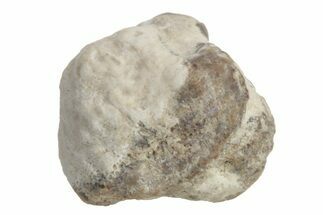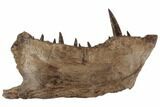This Specimen has been sold.
10.6" Xiphactinus Lower Jaw - Terror Of The Cretaceous Seas!
This is an awe-inspiring, lower jaw from the "Terror fish of the Cretaceous seas", Xiphactinus audax. It's 10.6" long and all of the teeth are original, not composites. It was collected from the Late Cretaceous, Smoky Hill Chalk Member of the Niobrara Formation in Kansas. This specimen has very nice preservation with 1 very large tooth accompanied by 8 smaller teeth. This jaw is a lean, mean chomping machine and can only be truly appreciated in person.
Comes with a display stand that compliments this fine specimen.
The restoration on this mandible is very minor, with only one repaired crack worth mentioning at the distal end of the jaw. Repairs were expertly done and only visible under UV light.
Xiphactinus was a huge predatory fish that lived during the Late Cretaceous. It would have been a voracious predator, growing 15-20 feet long. When alive, the fish would have resembled a gargantuan fanged tarpon. It appeared in the BBC's Sea Monsters and National Geographic's Sea Monsters: A Prehistoric Adventure, and was labelled a "Prehistoric Terror" in the Animal Planet show River Monsters.
Comes with a display stand that compliments this fine specimen.
The restoration on this mandible is very minor, with only one repaired crack worth mentioning at the distal end of the jaw. Repairs were expertly done and only visible under UV light.
Xiphactinus was a huge predatory fish that lived during the Late Cretaceous. It would have been a voracious predator, growing 15-20 feet long. When alive, the fish would have resembled a gargantuan fanged tarpon. It appeared in the BBC's Sea Monsters and National Geographic's Sea Monsters: A Prehistoric Adventure, and was labelled a "Prehistoric Terror" in the Animal Planet show River Monsters.
The Smoky Hill Chalk Member of the Niobrara Chalk formation is a Cretaceous conservation Lagerstätte, or fossil-rich geological formation, known primarily for its exceptionally well-preserved marine reptiles. It outcrops in parts of northwest Kansas--its most famous localities for fossils--and in southeastern Nebraska. Large, well-known fossils excavated from the Smoky Hill Chalk include marine reptiles such as plesiosaurs, large bony fish such as Xiphactinus, mosasaurs, pterosaurs, and turtles.
SPECIES
Xiphactinus audax
LOCATION
Gove County, Kansas
FORMATION
Niobrara Formation
SIZE
10.6" long
CATEGORY
SUB CATEGORY
ITEM
#197349
We guarantee the authenticity of all of our specimens.
 Reviews
Reviews














